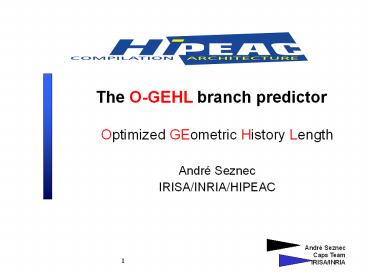The O-GEHL branch predictor - PowerPoint PPT Presentation
Title:
The O-GEHL branch predictor
Description:
Use an adder tree instead of a meta-predictor. Vintan and Iridon 99, ... Flipping from short to long histories and vice-versa. 10. The O-GEHL branch predictor ... – PowerPoint PPT presentation
Number of Views:162
Avg rating:3.0/5.0
Title: The O-GEHL branch predictor
1
The O-GEHL branch predictor
- Optimized GEometric History Length
- André Seznec
- IRISA/INRIA/HIPEAC
2
What is classic ?
- Global history based
- Yeh and Patt 91, Pan and So 91
- Use of multiple history lengths
- McFarling 93, Evers et al. 96
- Use an adder tree instead of a meta-predictor
- Vintan and Iridon 99, Jimènez and Lin 01
3
(No Transcript)
4
GEometric History Length predictor
The set of history lengths forms a geometric
series
0, 2, 4, 8, 16, 32, 64, 128
What is important L(i)-L(i-1) is drastically
increasing
5
Updating the predictor
- Update on misprediction and under a threshold
- 8-bit counters and perceptron update threshold
(29) - Would not have qualified for CBP-1 ?
6
Dynamic update threshold fitting
- On an O-GEHL predictor, best threshold depends
on - the application ?
- the predictor size ?
- the counter width ?
- By chance for the best fixed threshold,
- updates on mispredictions updates on correct
predictions - Monitor both numbers
- and adapt the update threshold
- 8 components 8 bits counter would qualify for
CBP-1 ?
7
Counter width on O-GEHL predictors
- 8 bits are just overkilling ?
- 4 bits are sufficient ?
- Mixing 5 bits for short histories and 4 bits for
long histories is slightly better ? - 3 bits are not so bad !!
8
Adaptative history length fitting (inspired by
Juan et al 98)
- (½ applications L(7) lt 50)
- ?
- (½ applications L(7) gt 150)
- Let us adapt some history lengths to the behavior
of each application - 8 tables
- T2 L(2) and L(8)
- T4 L(4) and L(9)
- T6 L(6) and L(10)
9
Adaptative history length fitting (2)
- Intuition
- if high degree of aliasing on T7, stick with
short history - Implementation
- monitoring of aliasing on updates on T7 through a
tag bit and a counter - Simple is sufficient
- Flipping from short to long histories and
vice-versa
10
TO
T1
T2
L(0)
?
T3
L(1) or L(5)
L(2)
T4
L(3) or L(6)
L(4)
Tag bits
11
Information to be hashed
- Address conditional branch history
- path confusion on short histories ?
- Address path
- Direct hashing leads to path confusion ?
- Represent all branches in branch history
- Use also path history ( 1 bit per branch, limited
to 16 bits)
12
Configuration for CBP
- 8 tables
- 2 Kentries except T1, 1Kentries
- 5 bit counters for T0 and T1, 4 bit counters
otherwise - 1 Kbits of one bit tags associated with T7
- 10K 5K 6x8K 1K 64K
- L(1) 3 and L(10) 200
- 0,3,5,8,12,19,31,49,75,125,200
13
Hashing 200 bits for indexing !!
- Need to compute 11 bits indexes
- Full hashing is unrealistic
- Just regularly pick at most 33 bits in
- addressbranch history path history
- A single 3-entry exclusive-OR stage
14
A case for the OGEHL predictor (1)
- High accuracy
- Robustness to variations of history lengths
choices - L(1) in 2,6, L(10) in 125,300
- misp. rate lt 1.04 x reference misp. rate
- Geometric series not a bad formula !!
- best geometric L(1)3, L(10)223, REF-0.02
misp/KI - best overall 0, 2, 4, 9, 12, 18, 31, 54, 114,
145, 266 REF-0.04 misp/KI
15
A case for the OGEHL predictor (2)
- Reduce counter width by 1 bit 49 Kbits
- would have been a finalist ?
- 64 Kbits 4 components OGEHL predictor
- would have been a finalist ?
- 50 Kbits 4 components OGEHL predictor (3-bit)
- would have been a finalist ?
- 768 Kbits 12 components OGEHL predictor
- 2.25 misp/KI
16
A case for the O-GEHL predictor (3)
- O-GEHL predictor uses only global information
- Can be ahead pipelined
- Prediction computation logic complexity is low
- (The End)































